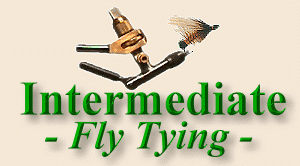Flesh flies are standard patterns used most often by steelhead and
pacific salmon folks. The idea is to make a fly that looks like a piece
of flesh that has been ripped off of a salmon by a bear or other predator
while the unlucky fish was trying to make its way to the spawning
grounds. If you add some white, it might look like the decaying flesh of
a salmon that finished the spawning task and expired as they always seem
to do. Once expired, their bodies feed countless animals and birds.
Some pretty large chunks of flesh always seem to get washed away to be
picked up by other salmon or large trout.
Bunny leeches are another type of flesh fly. The steps and techniques
are pretty much the same whether tying a bunny leech or a marabou flesh
fly. Whether you're wrapping rabbit fur strips or marabou feathers
around the hook, you still need to make sure you don't wrap over the
fluffy stuff, and that the fly "breathes" right. For those who wish to
tie bunny leeches, use these techniques but change the materials to
rabbit strips instead of marabou feathers.
One thing I find funny about flesh flies is that northern pike living in
lakes far from any salmon streams like to try to eat them. It seems
these morsels look like food to more than one type of fish. Catfish will
also grab one of these morsels if the opportunity is there.
Folks living near hydroelectric dams might want to try these flies below
the water discharge from the generator turbines. Trout and panfish often
slip into the water intakes for the power plants and exit in bite sized
chunks that big fish wait for downstream. Select colors that match the
predominant colors of the flesh and skin of the most common fish in the
lake.
You'll be surprised by the variety of fish you can catch below a
hydroelectric dam with this type of fly. The great thing about fishing
the water discharge areas is that the biggest fish in the river seem to
hold in those areas waiting for an easy meal. Flesh flies look like an
easy meal.
If you want to add weight, you can slip a bead or cone over the hook
before you begin tying the fly, or you can wrap lead wire around the hook
first. For a real heavy fly that keeps the hook pointing upward, try
hourglass or barbell eyes for weight.
Bass fishermen should tie this fly in the colors of common baitfish in
their area. The breathing action of the body is just the ticket to lure
some big hog bass into a feeding mood. Who would complain about a thing
like that?
|















